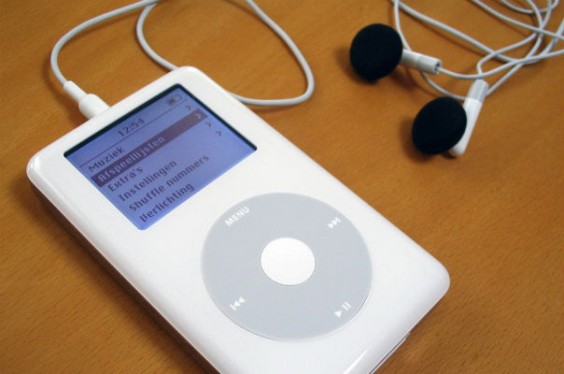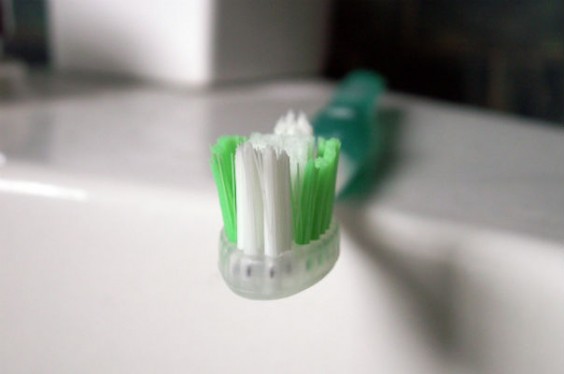Tips for Drinking
30. Sip Green Tea
Drinking green tea is one of the most
common tips for shedding a few pounds, and for good reason — green tea
is known for its ability to metabolize fat [44] [45]. And in combination with resistance training, green tea increases the potential for fat loss [46]. Add a squeeze of lemon for a little flavor and to amp up antioxidant affects [47].
31. Gulp H2O
Kick the diet beverages and vitamin enhanced money traps to the curb and reach for good ‘ole H2O instead. Drinking water helps people feel full, and as a result, consume fewer calories [48] [49]. Drinking water also significantly elevates resting energy expenditure (basically the number of calories we’d burn if we sat around all day) and lower water intake is associated with obesity [50] [51].
32. Sip before noshing
Pregaming a meal with a glass of water has been linked with more weight loss than cutting calories alone [52]. Take some mid-set breaks and guzzle a little water between bites too to give the brain time to register fullness [53].
33. Cut back on liquid cals
Milk and cookies, orange juice and French
toast, wine and cheese — some foods seemingly require a liquid
counterpart. But, it’s easy to pour on the pounds by chugging soda,
juice, alcohol, and even milk on the reg [54]. Sugar sweetened beverages are associated with increased body fat and blood pressure [55].
34. Water it down
When you’ve simply got to have a
swig of juice with that morning bowl of oatmeal, try watering it down.
While it may sound entirely unappealing, gradually adding more water
to less juice will keep some of the flavor without all the sugar and
calories. Added incentive: Increasing water intake in place of
sugar-sweetened beverages or fruit juices is associated with lower
long-term weight gain [56].
35. Choose tall and thin
So we know we said to cut back on the
juice and soda, but when you’ve got a hankering from some morning orange
juice, reach for a tall thin glass,
not a short squatty one. While it may sound like you’re discriminating
against your glasses, research shows that people pour less liquid into
tall narrow glasses than into their vertically challenged counterparts,
meaning we’ll ultimately (probably) drink less in one sitting. This is
especially helpful when drinking alcohol [57].
36. Banish the booze
We probably don’t have to tell you that
partying like an undergrad may pack on a few pounds. And you’ve likely
heard the phrase “drink in moderation.” The point is, alcohol houses a lot of sneaky calories
and it has the ability to inhibit eating decisions (mmm, greasy pizza)
later on in the night. Even after you’ve sobered up, alcohol can have
negative impacts on strength and may leave you lagging in the weight
room days later [58] [59].
Tips for Being Mindful
37. Brush those pearly whites
After dinner, go ahead and brush your teeth. Getting minty fresh breath not only has the obvious oral health benefits,
but can also keep you from mindlessly snacking while watching a pre-bed
TV show. Not a bad idea to hit up the floss, too. Once both deeds are
done, we may be more inclined to keep our mouths clean before bed.
38. Set realistic goals
It’s easy, especially come New Year’s
resolution season, to set some pretty unrealistic goals about weight
loss (fit into skinny jeans in three days!) [60]. Since impractical goals can slow down long-term weight-loss, it’s important to address those goals before making any health and fitness changes [61].
39. Portion patrol
Practicing portion control is one of the easiest, most reliable ways to lose weight, but it’s not an easy task [62] [63]. Portion distortion is ever present, but it may help to use portion visuals, for instance — a serving of chicken (3 ounces) is roughly the size of a deck of cards [64].
40. Stay Positive
Many of us demonize certain foods, and even punish ourselves for certain indulgences. Instead, positive messages
like “I can control my eating” or “I’m proud that I ate responsibly
today” can reframe our relationship with food. Research shows that
positive expectations are also associated with weight loss [65].
41. Think on it
How satiated we feel a few hours after we eat depends not on how much we actually scarfed down but on how much we think we ate. It pays to pay attention to what we eat... it’s actually okay to eat with our eyes [66].
42. Meditate
Emotional eating — essentially eating to make ourselves feel better (often when we’re sad or anxious) — can interfere with weight loss goals [67]. But meditation
— using techniques like muscle relaxation and achieving self focus —
can help binge eaters become aware of how they turn to food to deal with
emotions [68]. Check out these 10 ways to meditate.
43. Reel off mantras
Sometimes we just need a little fire
under our tushies to get motivated. If you’d rather forgo the literal
bonfire, try out some motivational mantras. Hang up an inspirational poster,
write it on a sticky note at work, or scribble it on your roommate’s
forehead when she’s sleeping as a reminder of your health and fitness
goals. Added plus: Mantras don’t cost a thing!
44. De-stress
A lot of stress can trigger increased eating and cravings, especially for sugary carbohydrates [69] [70]. If pressure at work or a family burden has got you feeling overwhelmed, try out one of these ways to reduce stress before pawing at that donut.
45. Add, don’t subtract
Instead of fixating on cutting out cookies, cake, pizza, and all that heavy cream in your morning coffee, focus instead on adding
healthy foods to your menu. Ditching all the “bad” stuff can be a
daunting task, one that’s easier to stick to by focusing on one habit at
a time (science says it takes anywhere from 18-254 days to form a habit). Add in as many healthy habits as you’d like — drink more water, stock up on fresh fruits and veggies — and slowly wean off of the not-so-good-for-you goodies.
46. One habit at a time
There’s an idea that focusing on less
helps us achieve more. Changing a habit is tough, but trying to tackle a
whole handful may seem impossible. Instead, concentrate on changing one behavior at a time.
Start small and make clear guidelines for a set habit. For example, if
you’d like to increase veggie intake, decide to eat three different
vegetables each day, or 1 cup with each meal. And remember, small
changes can lead to gradual weight loss [71] [72].
47. Envision the goal
Time spent visualizing
what you would look and feel like with a few less pounds, can help
acknowledge the health and fitness changes necessary for successful
weight loss. Research suggests that imagining achieving an exercise goal
— like running a 5k, or increasing weights for your next workout — can
actually enhance performance [73].
48. Think big picture
So you’ve “banned” chocolate cake, but decided to go for just a small taste.
Instead you polished off a full slice. It’s so easy to go totally
overboard on an old habit. Instead of blowing it if you’ve slipped up on
a new goal, think of the big picture. Focus on the change rather than what’s being eliminated (either a “bad” food, or a bad habit). Live in the moment to successfully make new healthy habits.
49. Sleep smart
Sleep
can not only reduce stress, help us heal faster, and prevent
depression, it can also help shave off some pounds because sleep loss is
linked to changes in appetite and the metabolism of glucose (sugar in the blood) [74]. Moral of the story: Sleep is associated with less weight gain [75] [76]. Take a look at our guide to sleep positions to optimize those hours spent tucked under the sheets. And try other solutions for extra Zzs like turning off electronics in the bedroom and avoiding large meals late at night [77] [78].
50. Get social
Check out online communities (like on
Facebook, Twitter, or other forums) that provide support and
encouragement. One study showed that overweight adults who listened to
weight-loss podcasts and used twitter in tandem with a diet and physical
activity monitoring app lost more weight than those who did not go social [79]. Sharing progress and setbacks on social media platforms can help users feel accountable for their goals.





























